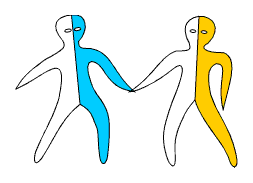Download This Content
APoGI for the Haemoglobin Disorders
![]()
Download This Content ![]()
This couple could have a child with a moderate anaemia called haemoglobin O Arab/beta thalassaemia.
| Partner who carries beta thalassaemia |  |
Partner who carries haemoglobin O Arab | |
 |
 |
 |
 |
| Not a carrier | Carrier of beta thalassaemia | Carrier of haemoglobin O Arab | Child with haemoblobin O Arab/beta thalassaemia |
In each pregnancy, there are four possibilities:
In each pregnancy there is a 3 out of 4 chance of a healthy child, and a 1 out of 4 risk of child with haemoglobin O Arab/beta thalassaemia.
... is a form of anaemia. Most affected people are not as strong as others and need extra care. A few have a very mild anaemia and lead a normal life, and a few have a severe anaemia and need a blood transfusion every month. We cannot reliably predict which carrier couples could have children with mild, moderate or severe haemoglobin O Arab/beta thalassaemia.
It is possible to test a baby for haemoglobin O Arab/beta thalassaemia early in pregnancy. This couple should see an expert counsellor in haemoglobin disorders to discuss their options, before starting a pregnancy, or as early in pregnancy as possible.
![]()
![]() Adobe Acrobat format (PDF) in colour and black-and-white
Adobe Acrobat format (PDF) in colour and black-and-white
![]() Microsoft Rich Text Format in colour and black-and-white
Microsoft Rich Text Format in colour and black-and-white
![]()
These documents are part of the APoGI May 1998 (Evaluation) Release and are made available subject to the APoGI Disclaimers covering usage, distribution and copying.
Problems or further enquiries to APoGI@chime.ucl.ac.uk or the APoGI Contacts
Copyright © 1984 -1998 UCL Medical School. All rights reserved.